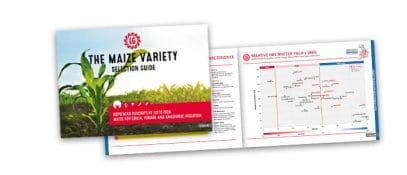Under-sowing maize with a hybrid ryegrass and red clover ley has delivered multiple benefits for Cornish dairy farmer Chris Sampson.
With five years of the practice under his belt, and now owning his own inter-row drill, Chris is seeing consistent results, and can list extra forage, increased soil carbon and reduced cultivations amongst the key advantages.
Chris is also eligible for a countryside stewardship payment of £172/ha for what is effectively a cover crop, and all of this is achieved with no detriment to his primary goal of growing a high energy maize crop.
“We grow around 40 acres of maize each year, which makes up about half of the winter forage ration for the milking herd,” Chris explains. “We now routinely under-sow it with a grass and clover mix, with the additional stewardship payment more or less paying for the seed. And, with the extra first cut of grass and clover silage we take the following spring, I’d say the whole exercise pays for itself in the first year.”
Maize was first grown at Metha Farm, near Newquay, around 25 years ago, and is now a mainstay of the milking ration for the 112-cow herd of Holstein Friesians. It is grown in rotation with grass and clover leys, with Chris favouring very early varieties that will produce a mature, high-energy crop in a relatively short growing season.
“We’ve tried growing wholecrop cereals as an alternative to maize, but could never achieve the same level of yield,” he adds. “It’s about maximising the energy production and the best measure of that is megajoules per hectare. With the system we now have, we’re able to exploit the full benefits of high energy maize whilst overcoming any environmental concerns with the crop.”
Grass and clover leys at Metha Farm are typically down for three or four years before that land is used for maize. The policy is usually to take a first cut from the old ley in early May before applying farmyard manure and then preparing the ground to drill maize.
“Our oldest leys are often still quite productive, and we’ll top-dress with nitrogen before taking a first cut,” explains Chris. “Once that crop is off, we have a fairly tight turn around to spray off the aftermath and apply muck before ploughing and preparing a seedbed.
“We find the right time to drill maize is at the end of May, or even the first week of June. We’ve tried drilling earlier but it’s usually better to wait until soil temperatures are higher. Even with the relatively late drilling we usually have a crop that hits the target of ‘knee high by the fourth of July’.”
Chris routinely soil samples all of the land going into maize, with the results determining his fertiliser policy for the crop. He may use up to 50kg/acre of DAP in the seedbed, and low level applications of nitrogen and/or MAP, or may decide there’s no requirement at all, adhering strictly to a principle of only applying what is necessary.
Once weeds have been sprayed off, and with the maize crop up to 12 inches high, Chris goes in with his Weaving inter-row drill, sowing a hybrid ryegrass and red clover mix at a regular seed rate of 14kg/acre.
“It’s a disc drill system and the coulters can be set to drill between the rows of maize,” says Chris. “The mix of hybrid ryegrass and red clover works best for our situation. The establishment is effective, so when the maize comes off in the autumn there’s a wispy crop growing underneath that kicks on very quickly.”
The priority for Chris is a mature crop of maize, so he resists the pressures to cut earlier and waits until the cobs are fit. In 2023 the maize came off on 8th October, with an overall fresh weight yield of around 17.5 tonnes/acre at 35.8% dry matter. With winter feeding well underway, the maize was feeding well, contributing a significant proportion to the total mixed ration for cows averaging 7,500 litres per lactation.
THE BENEFITS OF UNDERSOWING MAIZE
With undersowing becoming increasingly popular, Limagrain Maize Sales Manager, Tim Richmond, explains some of the wide-ranging benefits the practice has to offer.
The principal benefit of undersowing maize with a secondary crop such as ryegrass, clover, or vetch, or a combination of all three, is that it prevents maize stubbles from sitting bare over the winter. This not only reduces nutrient losses and soil erosion caused by run-off, but also makes travelling at harvest and in the subsequent spring easier, with the secondary crop helping to improve and bind soil structure.
The undersown crop also provides a valuable winter or spring crop for livestock to graze as well as providing a home for slurry to be spread in the early spring.
Undersowing also helps to improve soil biology, with worm counts typically 6-7 times higher compared to bare maize stubbles.
The secondary crop will also provide competition against spring germinating weeds, and, if conditions turn too wet to drill the next year’s crop, the land will still have a useful grass crop instead of sitting bare for a second winter.
Maize varieties such as Gema, Dignity, Saxon and Skipper are ideally suited for undersowing as they are early maturing which allows the cover crop to become further established after an early maize harvest, yet still go on to deliver a yield on par with the top performing varieties.
To achieve the best levels of cover crop establishment, the secondary crop should be drilled at a rate of around 15kg/ha (depending on the species and mixture) when the maize is at the 4-5 leaf stage. Avoid drilling the cover crop too late as an overly developed maize canopy will prevent the secondary crop from establishing properly, and ensure a gap of 15cm is left between the cover crop and maize drill rows to prevent any detrimental competition effect on maize yields.
Earlier maize suits rotational approachMaximising the milk produced from homegrown feed is the overriding aim for Cornish dairy farmer Richard Martin, not least because it is his surest route to profit.
With 1,000 high yielding cows on an autumn block calving system at Trethick Farm near Bodmin, Richard Martin relies on maize as the major energy source in the herd’s total mixed ration, with it making up 75% of the forage component during the period of peak lactation.
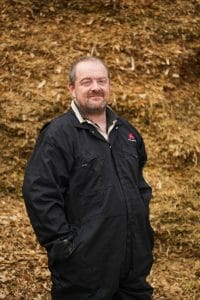 Achieving consistent yields of the highest quality maize, within a safe harvest window, is imperative, and this is being achieved by managing the crop expertly from seedbed to clamp and by choosing high ranking varieties, now mainly in the ‘very early’ maturity class.
Achieving consistent yields of the highest quality maize, within a safe harvest window, is imperative, and this is being achieved by managing the crop expertly from seedbed to clamp and by choosing high ranking varieties, now mainly in the ‘very early’ maturity class.
“We’re constantly looking at ways to fine tune our maize growing practice, through a combination of better management and ensuring we are using the best available varieties for our purpose,” says Richard.
“Most importantly, we’re growing maize as part of an overall system on the farm, so that it’s fully integrated with everything else that we’re doing.
“We’re rationalising the number of varieties we grow, down from as many as nine in any season to perhaps only three or four in the future. We’re growing 475 acres of maize and have three separate clamps, so ideally, we want three blocks reaching optimum maturity in turn across a manageable harvest period of two to three weeks.”
In 2023, which Richard ranks as one of the better years for growing maize in recent times, harvest started on 20th September and was completed by the first day of October, with crops averaging a fresh weight of approximately 15 tonnes/acre at 30% dry matter and 30% starch. In line with a policy of seeking out the best new varieties, Limagrain’s very early maturating variety, Foxtrot, was recommended to Richard and supplied by Graham Ragg of Mole Valley Farmers, and made a very successful debut on the farm, ‘ticking all the boxes’ for Richard.
“In the last ten years we’ve brought the maize harvest forward by two to three weeks, through the way we manage the crop and by selecting earlier maturing varieties. Very early varieties such as Foxtrot allow us more time, in better conditions, to establish a following crop.”
Maize rarely follows maize at Trethick Farm, but – on the rare occasions that it does – a cover crop is always drilled into the stubble: “Maize usually follows a cereal, or sometimes grass, but if we do have to grow maize after maize then we’ll sow a cover crop like mustard or forage rape,” Richard explains. “The latter gives us the option to graze over winter, but the most important factor is to ensure we avoid the risks of bare soils.”
Whether following a cereal, grass or a cover crop, the policy is always to plough before drilling, and every maize field is soil tested in good time.
“I see maize as a reset for the land, so we check the fertility and pH of every field and apply plenty of organic matter by spreading muck and slurry,” adds Richard. “The soil analysis will determine what fertiliser, if any, we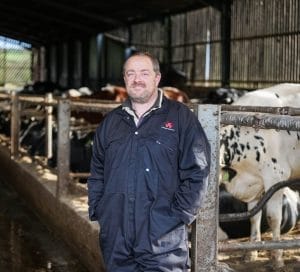 apply. There’s absolutely no point in routinely applying fertiliser if it’s not required, and we’re finding our ground is high in organic matter, with Ps and Ks often up at 4.
apply. There’s absolutely no point in routinely applying fertiliser if it’s not required, and we’re finding our ground is high in organic matter, with Ps and Ks often up at 4.
“By soil sampling and tailoring our soil nutrients accordingly, we’ve cut our use of DAP down the spout by half, with no detriment to crop performance.”
After ploughing, the typical approach is a deep cultivation pass with a Sumo Trio before power harrowing, and then using a drill mounted on a power harrow which ensures the fineness of seedbed that Richard feels is increasingly important.
“In the past two years we’ve moved to using pre-emergence herbicides as a routine, partly because the chemistry available for later spraying is less robust. The pre-ems are more effective with a finer seedbed, we find.
“Whether or not we apply any nitrogen will depend on the season. It’s now more of a tactical application if and when needed, rather than a routine, as we don’t want to waste resources where they aren’t needed.
“With modern varieties we don’t see the need for an eyespot spray, so really it’s then a case of monitoring the crop closely and being ready for harvest.”
Given the high feed rates for maize, Richard is not looking to take the crop too dry, so his target is 30% dry matter and 30% starch. To maximise the feed value of the ensiled crop, he pays close attention to ensuring the crop is properly consolidated in the clamp to optimise fermentation and preservation.
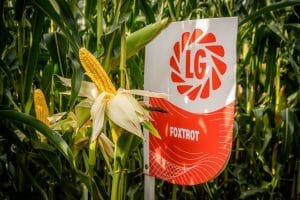 With maize silage providing the bulk of the herd’s energy requirements, cows are yielding a lactation average of 9,000 litres from twice daily milking, with high milk solids of 4.4% butterfat and 3.6% protein. The only feed bought-in to supplement the farm’s homegrown forages and cereals is a protein blend.
With maize silage providing the bulk of the herd’s energy requirements, cows are yielding a lactation average of 9,000 litres from twice daily milking, with high milk solids of 4.4% butterfat and 3.6% protein. The only feed bought-in to supplement the farm’s homegrown forages and cereals is a protein blend.
“We’re not feeding any concentrates in the parlour, and just use one mix across the board for all the milking herd,” says Richard.
“From a peak of 75%, the maize will come down to nearer 50% of the forage ration by the spring. We’re an early turn-out farm, so cows are usually going out to graze by day from mid-to-late February and will receive their TMR at night. By June and July, we’ll have a large part of the herd dry.”
Moving forward, Richard remains focused on continuing to improve production from homegrown feed, and that means becoming even better at growing maize. New varieties with improved digestibility like Foxtrot are an important part of the progress, but so are innovations in management.
“We’ll continue to challenge the way we grow our maize to seek marginal gains,” Richard concludes. “We’re trialling foliar applications of trace elements, for example, and may in future look at things like different seed rates. There’s always room for improvement with what is such an integral part of our system.”
Early maturing maize proves pivotal in rotation
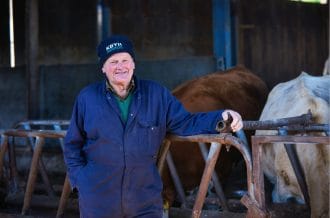 Increasing the acreage of maize in the arable rotation is proving highly successful for Warwickshire farmers Richard and Fred White at their 650ha mixed unit at Swan Farm, near Atherstone.
Increasing the acreage of maize in the arable rotation is proving highly successful for Warwickshire farmers Richard and Fred White at their 650ha mixed unit at Swan Farm, near Atherstone.
Seen firstly as a good alternative break crop to oilseed rape – which has become harder to establish due to the difficulties in controlling flea beetle – maize is now a valuable forage for their beef finishing enterprise as well as an additional cash crop sold to neighbouring dairy and goat farms.
Key to maize fitting into the rotation and also the operational schedule at Swan Farm is the use of a very early maturing variety, with Limagrain’s Gema fitting the bill well for the past two years.
“Harvesting a fully mature maize crop early is important to us for a number of reasons,” explains Richard White. “Firstly, we’re supplying longstanding customers that want the maize for feeding as early as possible, but we also want the fields cleared so that we can prepare the ground for drilling winter wheat.
“This year we harvested 52ha of Gema on 20th September, which was our contractor’s first outing of the season. We weigh representative trailer loads, so we know what we’re selling, and the crop averaged over 20 tonnes/acre fresh weight, which we’re very pleased with.”
Fresh crop samples were taken by Wynnstay’s Ellie Edwards just before harvest, with the analysis coming back at 32% dry matter, 34.4% starch and 11.5 MJ/kg ME, indicating optimum maturity and a high feed value forage. Having sold the seed, Ms. Edwards supported the customer with crop monitoring throughout the growing season and will continue her input through to feed out.
“It was a relatively positive season for growing maize in many areas,” she says, “with rainfall through July and August allowing good summer growth and enabling crops to yield well.”
At Swan Farm, the maize is drilled relatively early, with the 2023 crop going in during the last week of April. The early drilling is at least in part to ensure this job is out of the way before the fodder beet goes in.
“This is another reason why a very early variety like Gema works so well for us,” adds Richard. “Fodder beet is another important break crop in our rotation, and – like the maize – it’s both a cash crop that we sell as well as a valuable feed for our own sheep. By harvesting the maize as early as we do, it’s out of the way before we’re into lifting fodder beet. The two crops work well together in this way.”
Maize, fodder beet and also potatoes now provide the main cereal break crops in the rotation at Swan Farm, which grows up to 400ha of cereals, mainly winter wheat as well as some spring barley and spring oats.
“We’re doing everything we can to stay on top of grass weeds in our wheat, which is why productive break crops as part of a balanced rotation are so important,” says Richard. “We seem to be keeping on top of blackgrass at the moment, but need to be wary of other possible threats, like ryegrass. Staying on top of the problems is key.”
Swan Farm also includes 160ha of low input permanent grassland, which provides grazing for up to 200 cattle and a 450-ewe flock of EasyCare breeding ewes that are lambed in April. The permanent grassland, which is also used to produce hay sold into the equestrian market, helps to underpin a homegrown feed philosophy for both livestock enterprises.
“With the maize silage for finishing beef cattle, fodder beet for fattening lambs, plus our own spring cereals producing rolled barley and oats, we’re avoiding any great reliance on bought in feeds,” adds Richard. “It means our break crops are contributing to the other enterprises on the farm as well as being valuable in the rotation.”
As any effective rotation should, the cropping system at Swan Farm is helping to maintain good soil fertility as well as control weed and disease burdens.
 The 2023 crop of Gema maize only had farmyard manure and digestate applied prior to ploughing, with no fertiliser down the spout or applied later. Maize crops were also relatively clean, requiring just one herbicide application during the growing season.
The 2023 crop of Gema maize only had farmyard manure and digestate applied prior to ploughing, with no fertiliser down the spout or applied later. Maize crops were also relatively clean, requiring just one herbicide application during the growing season.
Going forward, as the Whites transition from the current HLS scheme, they are increasing their use of cover crops over the winter. Mixtures comprising mustard, fodder radish, millet and other species are now being grown, providing soil fertility benefits through green manure as well as useful shooting cover.
As they review new environmental scheme options, to work out what is best suited to their farm, one thing that’s fairly certain for the foreseeable future is a continuing commitment to growing very early maturing maize.
Creating carryover maize stocks helps maintain herd performance
A bumper 2023 maize crop looks set to eliminate any future risks of running short of a key forage for one high yielding Dorset dairy herd.
According to Robert Symms, who farms with his wife Bryony and son Jake at Batsons Farm, near Sherborne, growing a slightly increased maize acreage and opting for a top-ranked very early maturing variety should ensure the availability of important carryover silage stocks come the autumn of 2024.
“We’re estimating that we’ve clamped around 2,800 tonnes of maize this year, from 143 acres, so pretty much 20 tonnes/acre,” Robert reports. “That should mean we’ll have enough to last until Christmas 2024, so we can maintain a consistent ration all year round and avoid the issues of previous years when we’ve run short of maize before the new crop is fully fermented.”
Batsons Farm has evolved significantly over the last decade or so, firstly converting to a fully housed operation around 10 years ago, and in the last 12 months moving over to robotic milking. Over this period, a forage ration comprising approximately 60% maize and 40% grass silage has become established, fed as part of a total mixed ration through a forage wagon and underpinning yields that are now pushing up towards 12,500 litres/cow.
 The herd currently numbers 220 milking cows, with Robert conscious of the danger of any shortfall in maize production. He therefore turned to his seed supplier, Tim Rutter of Pearce Seeds, for advice on how to boost maize output.
The herd currently numbers 220 milking cows, with Robert conscious of the danger of any shortfall in maize production. He therefore turned to his seed supplier, Tim Rutter of Pearce Seeds, for advice on how to boost maize output.
“Based on the fact that we needed more yield, but still wanted a mature crop harvested before the end of September, Tim recommended Dignity from Limagrain,” Robert adds. “As a new variety, it had performed very well in Pearce Seeds’ own local trials and had all the attributes we were looking for.
“It was £10 a pack more than some of the other alternatives, but it has certainly performed for us, and I can now say it has been well worth the extra investment.”
Maize is usually drilled at Batsons Farm during the first week of May, and 2023 was no exception. It follows an over-winter cover crop of westerwold ryegrass, which provides a bonus cut of forage in early April and helps avoid the risks of bare ground during the wetter months.
“The cover crop will have had slurry on it in March and we apply farmyard manure after we’ve taken the cut of silage,” says Robert. “We then plough in the ryegrass stubble and prepare the ground for drilling with one or two passes with the power harrow. The maize is drilled by our contractor and goes in with one hundredweight to the acre of DAP down the spout. We’ve never seen the benefit of top dressing with any additional nitrogen fertiliser, so it’s simply a case of then allowing our agronomist to advise on herbicides, but our crops are generally pretty clean.”
In what has been a favourable year for growing maize in Dorset, the Dignity has performed exceptionally well,
maturing in good time for harvest before the end of September and yielding an impressive 20 tonnes/acre. Early sampling of the fresh, unfermented crop, taken from the clamp, revealed a dry matter of 34% and an ME of 11.2 MJ/kg, with starch at 28.6%. By the end of November, the fermented crop was analysed at 39.3% DM and 39.0% starch, with an ME of 11.96 MJ/kg. The ensiled crop was also shown to have a high percentage of fast digesting fibre and a low content of non-digestible fibre, both of which will ensure the crop feeds well and is easily assimilated in the rumen.
According to the farm’s nutritionist Vicky Ham, of Kite Consulting, forage budgeting that will, in future, allow the new maize to remain untouched for two or three months will be beneficial to overall herd performance.
“At Batsons Farm, the maize offers vital energy and a safe source of starch and is the foundation for the milkers and dry cow rations. We aim to feed a ratio of 60:40 maize to grass silage but can only do this with adequate silage stocks and fully fermented maize silage.
“When stocks run short, as we’ve seen this year and in previous years, there’s a risk of upsetting the rumen balance, and feeding the maize before the starch is at its most digestible equates to lost production potential.
“With the increased stocks resulting from the improved 2023 harvest with LG Dignity, we’re in a much better position from a forage budgeting perspective. Next year the new-season maize should remain untouched for two to three months after clamping and that will mean we’re maximising its value in the ration.”
With regards to the grass silage component of the ration, the Symms have moved towards a multi-cut system in recent years, starting early and taking as many as five or even six cuts a season, to maximise silage quality.
With input again from Pearce Seeds, they are now looking at four-to-five-year leys, with the addition of very large leaf white clover, which will not only boost the protein value of the grass silage but could also help to secure additional payments through the new Sustainable Farming Incentive schemes.
Limagrain varieties top the 2024/25 AHDB Recommended ListPlant breeder Limagrain’s winter wheat LG Beowulf and 2-row winter barley LG Caravelle, are the highest yielding varieties to join the 2024/25 AHDB Recommended List.
LG Armada also takes lead position as the highest yielding oilseed rape variety on the Recommended List for the UK, whilst LG Adeline takes pole position for oilseed rape in the North.
In addition, high yielding maize variety Saxon tops the 2024 BSPB Forage Maize Descriptive List for ME yield (‘000s MJ/ha).
This means that LG now offer the highest yielding varieties in; winter wheat, 2 row winter barley, OSR and maize*.

“This is an exceptional achievement for any breeder,” explains Ron Granger, Limagrain’s arable technical manager.
“Last year saw our winter wheat and winter barley varieties take pole positions across the RL. We have built on this success for a second year running, producing higher yielding varieties, backed up with desirable agronomic characteristics, securing high yield performance on farm. What’s more, these varieties have proven to be robust and consistent performers across seasons and regions.”
Highest yielding winter wheat
Group 4 hard wheat LG Beowulf yields 106% across the UK and shows the same consistency of performance across all regions: east (106%), west (106%) and the north (107%) – an outstanding achievement for any variety.
 LG Beowulf has produced these exceptionally high yields consistently in National List and RL trials over regions and seasons, in both the unusually dry summer of 2022 as well as the exceptionally wet summer of 2023. Alongside these yields, it offers a good grain quality, with a spec weight of 78.3 kg/hl.
LG Beowulf has produced these exceptionally high yields consistently in National List and RL trials over regions and seasons, in both the unusually dry summer of 2022 as well as the exceptionally wet summer of 2023. Alongside these yields, it offers a good grain quality, with a spec weight of 78.3 kg/hl.
“LG Beowulf is much like LG Skyscraper; it performs wherever you grow it,” he says. “It can be drilled early or late – providing growers with a wide drilling window, as a first or second wheat, on light or heavy land, and there are very few varieties that meet this criterion,” he says.
LG Beowulf yields are backed up by a set of strong agronomic characteristics, offering an excellent disease resistance profile with ratings of 9 for yellow rust, 6.7 for septoria, as well as orange wheat blossom midge (OWBM) resistance.
It has very stiff straw and is rated 8 for standing in untreated and PGR treated trials, which strongly contributes to its reliability on farm.
“In summary, LG Beowulf is a very high yielding, robust and versatile variety that comes at a time when growers are looking more than ever to maximise output, in order to maintain profit in times of increasing costs,” says Mr Granger.
Highest yielding winter barley
LG Caravelle is the highest yielding two-row winter barley for the second year running, since joining the Recommended List in 2023.
“Offering UK yields of 105.6%, LG Caravelle continues to dispel any misconception that two row barleys are lower yielding than hybrids. The variety certainly competes with the best yielding hybrid barleys, especially in the east,” says Mr Granger. “LG Caravelle is competitive in a black-grass situation, another characteristic that is normally associated with hybrids.” 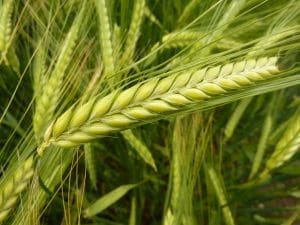
“LG Caravelle’s high yields are backed up by an excellent disease profile, reflected in its superb untreated performance, it is early maturing with stiff straw and good brackling resistance.”
“LG Caravelle also offers an exceptionally high specific weight for a winter barley, of 71.4 kg/hl combined with low screenings %,” he adds.
“Indeed, LG Caravelle possesses all of the key characteristics for a winter barley.”
LG Capitol is a two-row winter barley that joins the Recommended List this year and is a sister variety to LG Caravelle, offering similar yields and consistency of performance over seasons and regions. Its yields sit just 0.1% behind that of LG Caravelle, at 105.5%.
LG Capitol also combines a high specific weight and ripening, similar to KWS Tardis, with a solid disease resistance profile and good straw attributes.
Highest yielding OSR
The top three highest yielding oilseed rape varieties on the 2024/25 AHDB Recommended List all come from the Limagrain stable, offering exceptional consistency over regions and seasons.
LG Armada tops the UK and E/W List at 107%, LG Academic follows 1% behind at 106%, with LG Adeline taking pole position on the Northern List with an outstanding yield of 108.3%.
LG Armada is one of the next generation of versatile high yielding oilseed rape varieties, improving on the characteristic trait loaded-hybrids that growers have come to expect from Limagrain.
“‘Ambassador-like’ in its growth habit, LG Armada has strong autumn vigour, is robust, with good adaptability to all regions of the UK,” says Limagrain’s oilseeds product manager, Liam Wilkinson.
 “LG Armada is the first of our seventh generation of hybrids, bringing new maintainer and restorer lines to our OSR portfolio. This effectively means we are bringing varieties to market offering a stacked portfolio of much improved stem health attributes, alongside the standard pod shatter, TuYV and RLM7 resistance traits.”
“LG Armada is the first of our seventh generation of hybrids, bringing new maintainer and restorer lines to our OSR portfolio. This effectively means we are bringing varieties to market offering a stacked portfolio of much improved stem health attributes, alongside the standard pod shatter, TuYV and RLM7 resistance traits.”
“We know stem health is key to driving consistent oilseed rape yields across farms and with these seventh-generation hybrids, we are seeing bigger stems and better rooting which also results in higher oil content,” he says.
Highest yielding maize
Limagrain’s maize variety, Saxon was added to the BSPB 2023 Forage Maize Descriptive List and has made the top of the list for 2024 for its ME yield of 225 (‘000s MJ/ha). It has dry matter yields of 19.1 t/ha, making it ideal for all uses, including anaerobic digestion.

“On the Descriptive List, Saxon yields 105% of the average and additionally is quite an early variety with an FAO of 180,” says Tim Richmond, Limagrain’s product manager for maize.
“Saxon combines superb early vigour with good standing power, making it perfectly suited for all mainstream maize sites.”
“LGAN has long been the watchword for maize varieties that deliver what really counts – high yields of high-quality feeds that sustain excellent milk yields. Saxon is one of the latest examples of the benefit of breeding varieties that deliver in the clamp.”
To learn more about how any of these varieties could perform on your farm, click the links below;
LG Maize
LG Winter Wheat
LG Winter Barley
LG OSR
- * Data: 2024/25 AHDB RL / *2-row winter barley. 2024 BSPB NIAB Forage Maize Descriptive List – First choice varieties for favourable sites by ME yield of fresh plant at harvest (‘000s MJ/ha)
Limagrain UK is pleased to announce that the impending ban on maize seed treatments has been lifted following a successful lobbying campaign, with the granting of Emergency Authorisations allowing seed treated with three key seed treatments to be imported into and grown in the UK in 2024.
The future viability of maize being grown in the UK has been in question due to an impending ban on seed treatments not registered for use in the UK. These include Korit (ziram) bird deterrent, Redigo M (prothioconazole + metalaxyl) fungicide and Force 20 CS (tefluthrin) insecticide, with the use of all three products due to be banned from 31st December 2023. After this date it would have been illegal to import, sell or sow any seed which has been treated with any of these products, putting into doubt the future viability of maize grown for livestock forage or as a feedstock for anaerobic digestion (AD) plants.

Tim Richmond
“Without a suitable bird repellent, insecticide and fungicide, there’s a substantial risk that newly drilled crops could be completely wiped out by corvid grazing, or seriously hindered by insect damage and soil-borne pathogens,” explains Tim Richmond, Maize Manager for Limagrain Field Seeds in the UK and Ireland.
“To counter the ban, which has threatened the industry as a result of the UK’s departure from the EU, Limagrain set up and spearheaded an industry working group to lobby the Government into taking action. We can now announce that all three products have been granted an Emergency Authorisation, meaning that treated seed will be allowed to be imported into, and used in the UK next year.”
But the campaign doesn’t end here Mr Richmond continues. “Whilst the emergency use authorisations are a significant win for the industry, they are by no means a permanent solution. We are therefore continuing to lobby on behalf of all UK maize growers to secure a more sustainable solution in the form of a longer-term delay on the ban which will require a change in UK law, and will encourage the CRD (Chemicals Regulation Division) to ensure the next generation of maize seed treatments are approved at a regulatory level as quickly as possible.”
FIND OUT MORE ABOUT OUR MAIZE VARIETIES HERE
Pre-harvest tests indicate maize is on track to produce a promising cropPre-harvest crop analyses, carried out by Limagrain on behalf of local maize growers, indicate that most stands of maize are on track to produce a promising crop, with the majority predicted to be ready for harvest in the next week to 10 days.
The pre-harvest tests (for dry matter, starch, non-digestible fibre, cell wall digestibility and metabolisable energy content) were carried out at a maize demonstration and testing day, hosted by Limagrain and Spunhill at Limagrain’s maize variety trial site on the outskirts of Wrexham.
The event was attended by more than 40 farm businesses from across the region who not only had their own crop samples tested for free, but were also given a tour of the Limagrain variety trial where the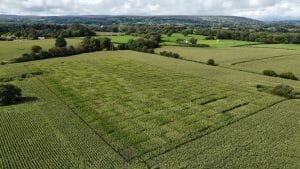 latest forage, grain and energy crop varieties are being assessed in an on-farm situation.
latest forage, grain and energy crop varieties are being assessed in an on-farm situation.
“The tests clearly indicated that whilst a minority of crops are already at the point of harvest, the majority are still a week or more away from being ready, with dry matter levels still a little on the low side,” describes Henry Louth, Key Account Manager, Forage Crops, Limagrain UK.
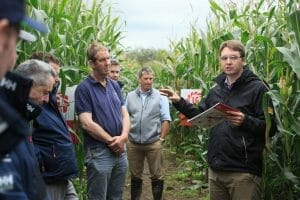
Henry Louth chatting to maize growers in Bangor on Dee
“For most maize growers, the start of this year’s harvest has been delayed by about a fortnight as a result of July’s dull and overcast conditions which saw sunshine hours at 81% of the average for the month. Most crops have caught up well since then, with a few notable ‘very early’ varieties including Dignity and Gema really standing out in terms of maturity. Those two varieties tested particularly well for dry matter, starch and ME content, and also recorded excellent results for cell wall digestibilty.
“If conditions in early October are favourable, we should see most growers taking their crops before the middle of the month, which will hopefully make for a clean and easy harvest and a good quality ensiled crop.”
The event was attended by by more than 40 farm businesses from across the region who had their maize crops tested for dry matter, starch and ME content, and cell wall digestibility.
The tests indicated that the majority of the region’s maize crops should be ready to be harvested by the middle of October.
Maize breeder optimistic of a reprieve for seed treatmentsLimagrain UK is optimistic that treated maize seed will still be available for the upcoming season as hope grows that the impending ban on seed treatments will be delayed following a successful lobbying campaign.

The future viability of maize being grown in the UK – either for use as livestock forage or as a feed source for AD (anaerobic digestion) plants – has been in question due to an impending ban on all seed treatments including Korit (ziram) bird deterrent, Redigo M (prothioconazole + metalaxyl) fungicide and Force 20 CS (tefluthrin) insecticide.
As it currently stands, from 31st December 2023 it would be illegal to import, sell or sow any seed which has been treated with any of these products, leaving crops at significant risk of failure.
“Without a suitable bird repellent, insecticide and fungicide, there’s a substantial risk that newly drilled crops could be completely wiped out by corvid grazing, or seriously hindered by insect damage and soil-borne pathogens,” explains Tim Richmond, Maize Manager for Limagrain Field Seeds in the UK and Ireland.
“Corvids are highly intelligent birds, and quickly understand seed drilling patterns, with any attempt to drill seed deeper to prevent bird damage likely to exacerbate the risk of seedling blight, making the application of a fungicide seed treatment such as Redigo M even more critical.”
To counter the ban, which has threatened the industry as a result of the UK’s departure from the EU, an industry working group – spearheaded by Limagrain UK – has been set up to lobby the Government into taking action.
“Limagrain has taken a leading role in this sector-wide campaign which has also included the MGA, AIC and NFU,” Mr Richmond continues. “A number of emergency authorisation (EA) applications have been made to the regulators for the continued use of these treatments for sowing in spring 2024, with a decision on whether the ban will be withdrawn or delayed due imminently.”
The Expert Committee on Pesticides is scheduled to meet in September, with a final announcement are expected to be made before the end of the month.
“As things currently stand, we’re confident that our ongoing discussions with the Farming Minister, the Rt. Hon. Mark Spencer MP, will have a favourable outcome and that all three seed treatments will still be available for use in 2024 – either as a result of the Emergency Authorisations being granted, or because of a change in the law to delay the withdrawal date.”
Despite the imminent announcement there remains significant uncertainty amongst UK maize growers, with some already suggesting they are preparing to sow an alternative crop such as wholecrop winter wheat.
“We appreciate that the clock is ticking and that for some growers any announcement might come too late,” Mr Richmond adds. “But until a concrete decision has been made, we’d urge growers not to rush into making any changes to next year’s rotation.
“We will know more in a relatively short timeframe and will announce the Committee’s decision as soon as it has been made known to us. In the meantime, we are continuing to lobby for the new generation of maize seed treatments to be registered with the CRD as quickly as possible to ensure maize remains a viable crop in the UK in the long-term.”
Limagrain UK will be exhibiting at the UK Dairy Day in Telford on Wednesday 13th September. Please feel free to visit stand H120 to discuss the latest situation with a member of the LG team.
Three Limagrain varieties top new maize Descriptive ListThree new forage maize varieties from Limagrain have been added to the 2023-24 BSPB/NIAB Descriptive List, with two very early maturing varieties sitting atop the new list of first choice varieties for favourable sites, and the third, a later maturing option, topping the list for very favourable sites.
Skipper and Foxtrot are ranked numbers one and two respectively as first choice varieties for starch yield on favourable sites, while LG31.207 tops the chart for ME yield for varieties suited to very favourable sites.
“With an early FAO of 160, an ME yield of 221,175 MJ/ha and the highest starch yield (6.74 t/ha) on this year’s favourable site list, Skipper is ideal for farmers who want to fill their clamps with a very early maturing crop of exceptionally energy-rich and starch-filled maize,” explains Tim Richmond, Maize Manager for Limagrain in the UK and Ireland.
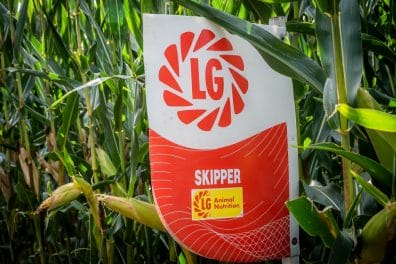
“Skipper also performs well on marginal sites, where its good early vigour (6.9), excellent standing power (7.6) and early ripening cobs deliver an easy to harvest crop that gives exceptional dry matter and energy yields.”
Foxtrot is also classified as a very early maturing variety (FAO 170) and is second only to Skipper in terms of starch yield (6.54 t/ha). Foxtrot also sits towards the top of the rankings for ME yield (222,363 MJ/ha) and DM yield (18.7 t/ha) and also shows good early vigour (7.2). “And with a Cell Wall Digestibility of 59.4%, Foxtrot is ideal for dairy and beef farmers who are looking for a bulky and very early maturing variety that will improve the feed conversion efficiency of their herd’s ration,” Mr Richmond adds.
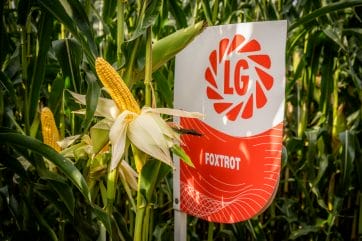
The third new Limagrain variety to be added to this year’s Descriptive List is LG31.207: with an FAO of 210, this intermediate to late-maturing variety is one of the best options for very favourable sites.
“LG31.207 is impressive on paper and in the field, and is the perfect choice for those growers looking to maximise their return on investment with a variety that poses minimal risk,” Mr Richmond describes.
“LG31.207 tops the Descriptive List for very favourable sites with an ME yield of 217,115 MJ/ha and dry matter yield of 18.7 t/ha ,” Mr Richmond continues. “And with excellent agronomic traits that include good standing power (8.0) , excellent early vigour (8.2) and an eyespot resistance rating of 7.5, LG31.207 is a really safe choice for growers looking for an energy-rich, easy to grow variety for AD purposes.”
|
VARIETY |
DM content (%) |
DM yield (t/ha) |
ME content (MJ/kg DM) |
ME yield (MJ/ha) |
Starch content (%) |
Starch yield (t/ha) |
Cell Wall Digestibility (%) |
Early vigour (1-9) |
Standing power (1-9) |
Leaf senescence (1-9) |
FAO |
|
CONTROLS: Favourable |
34.1 |
18.2 |
11.7 |
213,241 |
35.1 |
6.2 |
59.0 |
7.0 |
7.6 |
6.9 |
– |
|
SKIPPER |
35.9 |
18.8 |
11.8 |
221,175 |
35.9 |
6.74 |
58.8 |
7.2 |
7.8 |
7.3 |
160* |
|
FOXTROT |
35.3 |
18.7 |
11.9 |
222,526 |
35.3 |
6.54 |
59.4 |
7.2 |
6.7 |
7.3 |
170* |
|
CONTROLS: Very favourable |
34.5 |
18.1 |
11.5 |
207,131 |
32.0 |
5.8 |
57.0 |
7.3 |
7.5 |
5.6 |
– |
|
LG31.207 |
35.3 |
18.7 |
11.6 |
217,115 |
31.6 |
5.9 |
58.5 |
8.2 |
8.0 |
6.1 |
210* |
Source: BSPB/NIAB Forage Maize Descriptive List 2023-24.
Orange highlight: favourable sites. Blue highlight: very favourable sites.
* Limagrain estimate.
The 2024 Maize Variety Selection Guide is available now, it includes all the BSPB/NIAB data for Favourable, Less Favourable and Very Favourable sites, as well as additional LG data, giving you stacks of information to get stuck into, making your buying decision easier than ever before.
To download, click here!
Forage Maize Seed Treatment Withdrawal
Information: Forage Maize Seed Treatments for Sowing Spring 2024
Please click to fill out this survey to help
The Issue
Forage maize seed used in the UK is produced and pre-treated in Europe, with an appropriate fungicide to safeguard it against root zone diseases such as seedling blight, and a bird repellent to discourage corvids from taking the seed.
As part of the European Union free market, seed treated with a crop protection product has free movement across Member State boundaries. Now that the UK is no longer a member of the EU, such rules do not apply and, as of 31 December 2023, it will be illegal to import, sell or sow treated seed with Korit (ziram) bird deterrent, Redigo M (prothioconazole + metalaxyl) fungicide and Force (tefluthrin) insecticide, since the products are not licenced by the UK CRD/HSE.
The Impact
A lack of suitable bird repellent can result in the total loss of the crop. Corvids are intelligent birds and quickly understand seed drilling patterns. In the photograph below, the crows were able to identify which plots were untreated taking almost all of them.
Any attempt to drill the seed deeper to avoid bird damage exacerbates the issue of seedling blight, making application of a fungicide seed treatment such as Redigo M more critical.
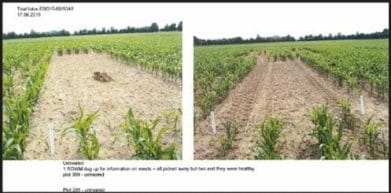
Alternatives
Current alternatives include the use of bird scarers, with the accompanying noise pollution, or control of corvids by shooting; neither of which make sense in today’s agriculture.
The danger is that farmers and growers turn away from the growing of forage maize, a high-density nutritious feedstock both for the dairy and livestock sectors, and for the anaerobic digestion industry for energy production.
What are we doing about it?
Limagrain, along with a number of other seed breeders have initiated a working group which has successfully galvanised the NFU, AIC and other parts of the industry into action. Letters to MPs, Select Committees and Ministers have either been sent or are in the process of being sent. Civil servants have been contacted and the media “activated”.
How You could Help
We are keen that as many MPs as possible are aware of this issue:
1. Complete this survey put together by the MGA and NIAB which will give a deeper insight into the issue and who it’s affecting
2. Would you consider writing to your local MP on this subject?
3. Can you raise the problem with their local NFU representatives?
4. Evidence: we are definitely on the hunt for photos of where untreated seed has been planted and anecdotes thereof. Have you seen this problem in action?
Mind the Forage Gap!
After last year’s cold and dry spring resulted in some meagre first cut crops of silage, livestock farmers are looking for ways to ensure their silage clamps are fully filled this autumn. One option, according to Limagrain’s Tim Richmond, is to grow more maize.
“The severity of last year’s poor grass yields was highlighted by the sight of livestock farmers harvesting the last flushes of grass

Maize Product Manager Tim Richmond
growth as late as October and even into November,” Mr Richmond comments. “The silage those crops yielded will have been of questionable nutritional value, but with purchased feed prices as high as they were farmers had to do whatever it took to ensure they had enough feed to see them through the winter. As such, they will understandably be keen to avoid a repeat this year.”
One option to mitigate the risks associated with another difficult spring is to grow more maize Mr Richmond explains: “A well-managed crop of maize will be less susceptible to the stresses which led to last year’s grass problems,” he states, “with modern maize varieties able to deliver strong yields even when the growing season is foreshortened by late drilling.”
Mr Richmond explains that the latest generation of maize varieties require 10% fewer heat units than their predecessors and can be drilled up the end of May. “Limagrain’s European maize breeding programme has focused on producing new varieties with improved vigour and which require fewer Ontario Heat Units to reach maturity earlier in the year.
“We also breed and select varieties based on their stability of performance and standing power under the varying conditions that the UK climate can throw at crops, with our vigorous UK trials programme ensuring we only bring to market those new varieties which are truly suited to local conditions.
 “Varieties such as Gema, Prospect, Dignity and Trooper all have an FAO rating in the 160-180 range which means they can be drilled later and harvested sooner. And, despite requiring a shorter season to reach maturity, they can still reliably produce clamp-filling yields of 16.5-18.3tDM/ha, almost twice as much as most grass leys will produce in the same timeframe.”
“Varieties such as Gema, Prospect, Dignity and Trooper all have an FAO rating in the 160-180 range which means they can be drilled later and harvested sooner. And, despite requiring a shorter season to reach maturity, they can still reliably produce clamp-filling yields of 16.5-18.3tDM/ha, almost twice as much as most grass leys will produce in the same timeframe.”
These varieties will also deliver a higher energy yield Mr Richmond says: “For example, 10ha of Trooper (FAO 170) can be expected to produce around 180 tonnes of dry matter and could easily be the difference between having enough forage in the clamp and having to choose between restricting forage intakes or purchasing additional feed.
“But it’s not just dry matter yield or earliness of maturity that matters,” Tim continues. “Fifty percent of the energy in maize is stored in the stalk and leaves of the plant so it’s important to select a variety which is easily digested in the rumen. In older varieties, this vegetative material was harder for livestock to process so Limagrain’s maize breeding programme has focused on ensuring those same high-yielding varieties also deliver more readily available energy by breeding in improved cell wall digestibility (CWD).”
Mr Richmond concludes by stating that the inclusion of more maize into dairy and beef diets has the added advantage of supporting improved rumen function and encouraging greater feed intake which translates into better milk yields and improved daily live weight gains.
“Growing an early maturing variety also gives farmers the option to establish a successor crop in the autumn and for that crop to be used as an early source of fresh forage in the following spring,” he advises.
Mitigating maize malaiseLast year’s testing weather conditions have brought into focus the challenges maize growers can face when trying to produce a high-yielding, nutritionally valuable crop.
With last year’s dry and hot conditions causing many crops to underperform and in the worst cases fail, Limagrain’s Tim Richmond and Neil Potts of Matford Arable share their thoughts on how to mitigate the effects of variable weather patterns, disease and pest-related stresses.
According to Tim Richmond, maize manager for Limagrain, the key factors to consider when planning for a successful maize crop are varietal agronomics, drilling depth and seedbed conditions, minimising the threat from pests, disease and birds, and ensuring the crop matures early enough to enable a timely harvest without risking excessive soil compaction, erosion or run-off.
“With weather patterns becoming increasingly volatile and difficult to predict, it pays more than ever to plan carefully for the season ahead to ensure maize crops stand the best chance of achieving their true potential in terms of yield and energy content,” Mr Richmond explains.
“What last year’s excessively hot and arid conditions taught us is that it’s crucial to get crops off to a strong start so they are better able to cope with stresses later in the season.
“Growers should therefore select the most appropriate variety for their specific location and preferably one which has been tested and proven in UK conditions.”
“Factors including available heat (measured in Ontario Heat Units) and average rainfall will dictate whether a ‘very early’ variety such as Prospect, an ‘early’ variety such as Saxon or an ‘intermediate’ maturing variety such as LG31207 should be grown”.
“That’s as true for maize grown for ensiling as it is for crimped or grain maize and for crops destined for biogas production, but there’s never any guarantee the season will pan out as expected. Therefore, to give the selected variety the best start, additional care is required at drilling and during the establishment phase.
Mr Richmond explains that drilling should only commence once the soil temperature has reached 10oC for at least four consecutive days and when the medium-term forecast looks favourable, “so seed germinates quickly and plants grow away strongly. Crops should also be drilled into well-aerated soils as maize won’t thrive in compacted soils where oxygen is limited. A starter fertiliser – applied with the seed at drilling – will also help the crop to grow away quickly.”
How crops coped during last year’s drought came down to how they fared during the establishment phase Mr Richmond adds: “Crops drilled into a warm, well-aerated seedbed with a decent amount of retained moisture rapidly put down strong roots which helped them to cope with the ensuing dry conditions and allowed them to develop an early canopy which helped to out-compete and suppress weeds”.
“In contrast, those crops which went into drier ground, either as a result of poor timing, lack of rainfall or where heavy cultivation had caused excessive moisture losses, failed to put down a decent root and suffered more as the dry conditions took hold.”
In terms of specific agronomic traits, Mr Richmond recommends looking not just at the usual performance indicators – dry matter yield and starch content – but at additional factors including early vigour, lodging ratings, disease resistance and maturity classification.
“Irrespective of the crop’s end-use, there’s no point chasing outright yield if the crop doesn’t contain enough metabolisable energy or if it grows too tall for its root structure and ends up lodging. A variety which puts down strong roots stands a better chance of remaining upright and will also be able to grow away more quickly and withstand dry conditions for longer thanks to the ability to scavenge water and nutrients from depth.
“Likewise, a crop with natural resistance to diseases such as stalk rot (Fusarium graminearum) will also be easier to grow, although it will still pay to manage disease carefully, particularly if the season turns out to be less than ideal.”
Neil Potts of Matford Arable agrees, stating that cool and humid conditions will aggravate the threat of disease. “Thankfully, the cool, damp conditions which exacerbate diseases have been relatively scarce in recent years, but it still pays to be aware of the risk especially as fusarium can be tricky to control once it has taken hold. It therefore makes sense to thoroughly bury the previous crop’s stubbles and debris to reduce diseases from over-wintering and to have plans in place should a fungicide application be required.
“In recent years, the drive to reduce costs has resulted in a small but significant groundswell towards establishing maize either via direct drilling or minimum tillage. In a favourable year these techniques work reasonably well, although the resulting crops can be a little smaller than their conventional counterparts. It is worth noting however, that last year’s conditions proved too much for reduced tillage crops in the driest parts of the UK which struggled because of their less-developed root systems and because many of the drills used didn’t have the ability to apply a seedbed fertiliser.”
Seed treatments and biological growth enhancers can also help to mitigate the effects of a poor season: “With feed prices remaining high the value of home-grown forage has also risen,” Mr Richmond continues. “It therefore pays to protect crops from the very outset, with seed treatments such as Korit Pro which, as well as repelling birds and protecting against damping off diseases such as pythium, also provides manganese and zinc to improve crop emergence and establishment through the susceptible 2-6 leaf period. It also contains a plant growth promoting rhizobacteria (PGPR) which colonises the rootzone and aids nutrient uptake, thereby giving plants a healthier start.
“Ultimately, the key factor affecting how a crop performs at harvest is how well it was managed in its infancy,” Mr Richmond concludes. “It’s therefore essential to do everything possible to get crops off to a vigorous start so that they stand a better chance of coping with whatever the season might subsequently throw at them.”






























